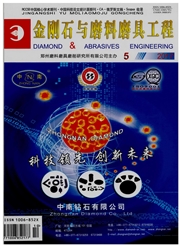

 中文摘要:
中文摘要:
用白光干涉检测(WLI)法检测微结构表面形貌时,其光滑结构面和边角数据很容易丢失,因此本文提出了自适应方向WLI检测法.该方法分别沿着每个微斜面法向进行自适应方向检测,评价分析其面形、特征轮廓和特征点的加工精度.首先,采用# 3000金刚石砂轮微细尖端在Si表面加工出高度为50 μm、宽度为56 μm且光滑的微锥塔结构.然后,利用四次检测点云对微磨削表面进行拼接与重建.最后,分析面形误差、特征轮廓误差和特征点误差.实验显示:自适应方向WLI检测可以重构出完整的微锥塔结构表面,微磨削的面形误差为5.3 μm,表明该微磨削技术可以确保微锥塔结构光滑Si表面的加工精度.但是,对微锥塔结构表面特征轮廓误差及特征点误差的评价表明,特征轮廓误差高达7.7μm,而特征点误差约为15 μm,约为面形误差的3倍.分析认为这些误差是由微金刚石砂轮V形尖端磨钝及微磨粒钝化造成的.
 英文摘要:
英文摘要:
When a White Light Interferometry (WLI) is used to measure the micro-structured surface topography,the measured points on smooth micro-structured surfaces and edges are easy to lose.Therefore,an adaptive-orientation WLI was proposed.The method measured each steep surface along its near normal-orientation for the evaluation of its surface shape,feature profile and micro-machining accuracy.First,a # 3000 diamond wheel V-tip was employed to fabricate a micro-pyramid-structure Si surface with a depth of 50 μm and a width of 56 μm.Then,four adaptive-orientation measured point clouds were used to splice and reconstruct whole micro ground surface.Finally,the microground form error,feature profile error and the feature point error were investigated.Experiments show that the adaptive-orientation measurement can reconstruct integrated micro-pyramid-structured surface and the form error is 5.3 μm,which means that the micro-grinding may assure the machining accuracy of micro-pyramid-structured Si surface.In contrast,the evaluation for the feature profiles and feature points of a micro-pyramid-structure indicates that the feature profile error reaches 7.7μm,and the feature point error is about 15 μm,which is about 3 times of its form error.It suggests that these errors come from the passivations of diamond wheel V-tip and micro grains.
 同期刊论文项目
同期刊论文项目
 同项目期刊论文
同项目期刊论文
 3D laser investigation on micron-scale grain protrusion topography of truncated diamond grinding whe
3D laser investigation on micron-scale grain protrusion topography of truncated diamond grinding whe Experimental investigation on various tool path strategies influencing surface quality and form accu
Experimental investigation on various tool path strategies influencing surface quality and form accu Evaluation on 3D micro-ground profile accuracy of micro-pyramid-structured Si surface using an adapt
Evaluation on 3D micro-ground profile accuracy of micro-pyramid-structured Si surface using an adapt Experimental study on dry electrical contact discharge (ECD) dressing parameters of coarse diamond g
Experimental study on dry electrical contact discharge (ECD) dressing parameters of coarse diamond g Study on axial-feed mirror finish grinding of hard and brittle materials in relation to micron-scale
Study on axial-feed mirror finish grinding of hard and brittle materials in relation to micron-scale Experimental study on fabrication and evaluation of micro pyramid-structured silicon surface using a
Experimental study on fabrication and evaluation of micro pyramid-structured silicon surface using a Dry electro-contact discharge mutual-wear truing of micro diamond wheel V-tip for precision micro-gr
Dry electro-contact discharge mutual-wear truing of micro diamond wheel V-tip for precision micro-gr Effect of cutter rake angle on cutter V-tip wear and micro-groove quality in micron-scale turning of
Effect of cutter rake angle on cutter V-tip wear and micro-groove quality in micron-scale turning of 3D Noise Generation and Removal of Measured Grinding Wheel Topography Using a White Light Interferom
3D Noise Generation and Removal of Measured Grinding Wheel Topography Using a White Light Interferom Experimental study on cutting temperature and cutting force in dry turning of titanium alloy using a
Experimental study on cutting temperature and cutting force in dry turning of titanium alloy using a 期刊信息
期刊信息
